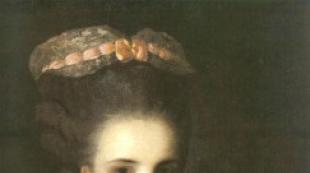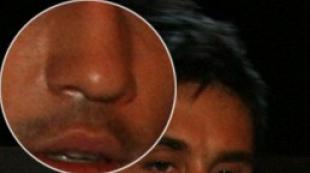Doctor surgeon n and pies. Biography. The value of scientific activity
The great surgeon and scientist Nikolai Pirogov was once nicknamed "the wonderful doctor". Real legends circulated about cases of amazing healing and his unprecedented skill. The doctor did not see the difference between the rootless and the noble, the poor and the rich. He operated on absolutely everyone, and devoted his whole life to this vocation. The activities and biography of Nikolai Ivanovich Pirogov will be presented to your attention below.
First idol
The biography of Nikolai Pirogov began in November 1810 in Moscow in a large family. Among the brothers and sisters, the future surgeon was the youngest.
My father worked as a treasurer. Therefore, the Pirogov family has always lived in abundance. The education of offspring was more than thoroughly involved. The head of the family has always hired the best teachers. Nikolai first studied at home, and then began to receive education in one of the private boarding schools.
Not surprisingly, as an eight-year-old boy, the future surgeon was already reading. He was impressed by the works of Karamzin as well. In addition, he was fond of poetry, and also wrote poetry himself.
The famous doctor, a friend of the family, Efim Mukhin, often visited the Pirogovs' house. He began to heal even under G. Potemkin. Once he cured his brother Nikolai from pneumonia. The future surgeon watched his actions and began to play the good doctor Mukhin, imitating him in everything. And when young Nikolai was presented with a toy stethoscope, Mukhin himself drew attention to the child and began to study with him.
To be honest, the parents thought that this childhood hobby would pass over time. They hoped that the son would choose a different path, a more noble one. But it so happened that it was medical activity that turned out to be the only way of survival, not only for an impoverished family, but also for Nikolai himself. The fact is that a colleague of Pirogov Sr. stole a huge amount of money and disappeared. The father of the future surgeon, as a treasurer, had to make up for the shortfall. I had to sell most of the property, move from a large house to a small apartment, limit myself in everything. A little later, my father could not stand such tests. He was gone.

Student body
Despite the deplorable situation of the once wealthy family, Nikolai's mother decided to give him an excellent education. All the family's remaining money, in fact, went to training the future surgeon.
Fourteen-year-old Nikolai became a student of the medical faculty of Moscow State University, adding 2 years to himself upon admission.
At the university, Pirogov succeeded in literally everything - he absorbed knowledge with enviable ease and managed to earn extra money in order to help the family. I got a job as a dissector in one of the anatomical theaters. Working there, I finally realized that he wanted to become a surgeon.
When the young doctor was already graduating from the university, the understanding came to him that the authorities did not need domestic medicine. He was disappointed. For all the years of study at Moscow State University, he did not perform a single operation. And so he hoped that he would come to grips with surgery and science.

Dorpat-Berlin-Dorpat-Paris
Having brilliantly graduated from the university, Pirogov went to Dorpat. He began working in a surgical clinic at the university. Note that this university was then considered one of the best in the country.
The young specialist worked in this city for five years. He finally took up a scalpel and practically lived in the laboratory.
Over the years, Pirogov wrote his doctoral dissertation and defended it magnificently. He was then only twenty-two.
After Dorpat, the scientist arrived in the capital of Germany. Until 1835, he again studied surgery and anatomy. Thus, Professor Langenbeck taught him the purity of surgical methods. By this time, his dissertation was also translated into German. Rumors of a talented surgeon began to spread throughout all cities and countries. His fame grew.
From Berlin, Pirogov again went to Dorpat, where he headed the department of surgery at the university. He already operated independently then. The young man managed to show his excellent skill as a surgeon. In addition, he published a number of his scientific works and monographs. These works strengthened his great authority as a scientist.
During this period, Pirogov also visited Paris, examined the best metropolitan clinics. Note that he was disappointed with the work in such institutions. Moreover, the death rate in France was very high.

In Petersburg
As evidenced short biography Pirogov Nikolai Ivanovich, in 1841 he began to work at the University of St. Petersburg at the Department of Surgery. Overall, I worked there for ten years.
His lectures were attended not only by students, but also by students from other universities. Newspapers and magazines constantly published articles about the talented surgeon.
After some time, Pirogov became the head of the Tool Factory. From now on, he himself could invent and design medical instruments.
He also started working as a consultant in one of the St. Petersburg hospitals. The number of clinics to which he was invited grew rapidly.
In 1846 Pirogov completed the project of the Anatomical Institute. Now students could study anatomy, learn to operate and conduct observations.

Anesthesia test
In the same year, the test of anesthesia was successfully passed, which began to conquer all countries with enviable speed. In just one year, 690 operations were performed in 13 Russian cities under ether anesthesia. Note, 300 of them were made by Pirogov!
After some time, Nikolai Ivanovich arrived in the Caucasus, where he participated in military clashes. Once, during the siege of an aul called Salty, Pirogov had to perform operations on the wounded under anesthesia in the field. This was the first time in the entire history of medicine.
War in Crimea
In 1853, the Crimean War began. A short biography of the doctor Nikolai Ivanovich Pirogov contains information that he was sent to the active army in Sevastopol. The doctor had to work in terrible conditions, in huts and tents. But nevertheless he spent great amount operations. At the same time, surgical interventions were carried out only with ether anesthesia.
It was also during this war that a physician first used a plaster cast. In addition, thanks to him, the institute of "sisters of mercy" appeared.
The surgeon's popularity grew steadily, especially among ordinary soldiers.
Opal
Meanwhile, Pirogov returned to the capital. He reported to the sovereign about the illiterate leadership of the Russian army. However, the autocrat did not at all heed the advice of the famous doctor. And he fell out of favor. Pirogov left the St. Petersburg Academy, became the trustee of the Kiev and Odessa educational districts.
Pirogov Nikolai Ivanovich (a short biography of this) tried to change the entire education system in schools. But in 1861, such actions led to a serious conflict with the local authorities. As a result, the scientist was forced to resign.
Over the next four years, Pirogov lived abroad. He headed a group of young professionals who went there for academic qualifications. As a teacher, Pirogov helped a lot of young people. So, it was he who was the first to unravel his talent in the famous scientist I. Mechnikov.
In 1866, Pirogov returned to his homeland. He came to his estate near Vinnitsa and organized a hospital there. And it's free.

Last years
A short biography of Nikolai Ivanovich Pirogov for children contains information that he lived on the estate almost without a break. Only sometimes I went to the capital and to other countries. The famous surgeon was invited there to give his lectures.
In 1877, the Russian-Turkish war began. And Pirogov again found himself in the midst of terrible events. He arrived in Bulgaria and, as always, began to operate on the soldiers. By the way, as a result of the military campaign, the famous surgeon published his next work on "military medicine" in Bulgaria at the end of the 70s of the nineteenth century.
In the spring of 1881, the public celebrated the half-century anniversary of Pirogov's scientific work. Honoring Scientist Profits famous people from different countries. It was then, during the celebrations, that he was diagnosed with a terrible diagnosis - oncology.
After that, Nikolai Ivanovich went to Vienna to be operated on. But it was too late. At the very beginning of December 1881, the unique scientist was gone.

By the way, shortly before his death, Pirogov discovered new way embalming the deceased. By this method, the body of the surgeon himself was also embalmed. It is buried in a tomb on his estate.
Surprisingly, in this territory during the Great Patriotic War there was one of the Fuhrer's headquarters. The invaders did not disturb the remains of the great doctor.
Nikolai Pirogov: biography, personal life
Nikolai Pirogov was married twice. The first wife of the surgeon was Ekaterina Berezina. She was born into a noble but severely impoverished family. She lived in marriage for only four years. During this time, she managed to give Pirogov two sons. The wife died giving birth to her youngest son. For Pirogov, the death of his wife was a terrible and heavy blow. By and large, he blamed himself for a long time and believed that he could save his wife.
After the death of his wife, Nikolai Ivanovich Pirogov, a brief biography of which is presented to your attention in the article, tried to get married two more times. All these cases were unsuccessful. And then he was told about a certain 22-year-old girl. She was nicknamed "the lady with convictions." We are talking about Baroness Alexandra Bistrom. She admired the scientist's articles and, in general, was very interested in science. Thus, Pirogov found a woman close in spirit.
The scientist proposed to Bistrom, and she, of course, agreed. After the marriage, the couple began to operate on the patients together. Pirogov supervised the process of the operation itself, and the baroness assisted him. The great surgeon was then forty years old.
The future great doctor was born on November 27, 1810 in Moscow. His father served as a treasurer. Ivan Ivanovich Pirogov had fourteen children, most died in infancy; of the six survivors, Nikolai was the youngest.
An acquaintance of the family, a well-known Moscow doctor, professor of Moscow University E. Mukhin, who noticed the boy's abilities and began to study with him individually, helped him get an education.
When Nikolai was fourteen years old, he entered the medical faculty of Moscow University. To do this, he had to add two years to himself, but he passed the exams no worse than his older comrades. Pirogov studied easily. In addition, he had to constantly earn extra money to help the family. Finally, Pirogov managed to get a job as a dissector in the anatomical theater. This work gave him invaluable experience and convinced him that he should become a surgeon.
Having graduated from the university one of the first in academic performance. Pirogov went to prepare for professorship at Yuriev University in the city of Tartu. At that time, this university was considered the best in Russia. Here, in a surgical clinic, Pirogov worked for five years, brilliantly defended his doctoral dissertation and at twenty-six became a professor of surgery.
The topic of his thesis, he chose the ligation of the abdominal aorta, performed until that time - and then with a fatal outcome - only once by the English surgeon Astley Cooper. The conclusions of Pirogov's dissertation were equally important for theory and practice. He was the first to study and describe the topography, that is, the location of the abdominal aorta in humans, circulatory disorders during its ligation, the path of blood circulation in case of its obstruction, and explained the reasons for postoperative complications. He proposed two methods of access to the aorta: transperitoneal and extraperitoneal. When any damage to the peritoneum threatened death, the second method was especially necessary. Astley Cooper, who for the first time ligated the aorta by the transperitoneal method, said after reading Pirogov's dissertation that if he had to do the operation again, he would have chosen a different method. Isn't this the highest recognition!
When Pirogov, after five years in Dorpat, went to Berlin to study, the famous surgeons, to whom he went with his head bowed respectfully, read his dissertation, hastily translated into German.
He found the teacher who more than others combined everything that Pirogov was looking for in the surgeon, not in Berlin, but in Göttingen, in the person of Professor Langenbeck. Göttingen's professor taught him the purity of surgical techniques. He taught him to hear the whole and complete melody of the operation. He showed Pirogov how to adapt the movements of the legs and the whole body to the actions of the operating hand. He hated slowness and demanded fast, precise and rhythmic work.
Returning home, Pirogov fell seriously ill and was left for treatment in Riga. Riga was lucky: if Pirogov did not get sick, it would not have become a platform for his rapid recognition. As soon as Pirogov got up from the hospital bed, he undertook to operate. The city had heard rumors about a promising young surgeon before. Now it was necessary to confirm the good fame that had fled far ahead.
Best of the day
He started with rhinoplasty: a noseless barber carved out a new nose. Then he recalled that it was the best nose he ever made in his life. Plastic surgery was followed by the inevitable lithotamiya, amputation, removal of tumors. In Riga, he operated as a teacher for the first time.
From Riga, he went to Dorpat, where he learned that the Moscow department promised to him had been given to another candidate. But he was lucky - Ivan Filippovich Moyer gave his student his clinic in Dorpat.
One of the most significant works by Pirogov is the Surgical Anatomy of the Arterial Trunks and Fascia, completed in Dorpat. Already in the name itself, giant layers are raised - surgical anatomy, a science that Pirogov created from his first youthful works, and the only pebble that started the movement of the masses is the fascia.
Before Pirogov, they almost did not deal with fascia: they knew that there were such fibrous fibrous plates, membranes surrounding muscle groups or individual muscles, saw them, opening corpses, stumbled upon them during operations, cut them with a knife, not giving them any importance.
Pirogov begins with a very modest task: he undertakes to study the direction of the fascial membranes. Having learned the particular, the course of each fascia, he goes to the general and deduces certain patterns of the position of the fascia with respect to nearby vessels, muscles, nerves, reveals certain anatomical patterns.
Everything that Pirogov discovered, he does not need by itself, he needs all this in order to indicate the best methods of performing operations, first of all "to find the correct way to ligate this or that artery," as he says. This is where the new science created by Pirogov begins - this is surgical anatomy.
Why does a surgeon need anatomy at all, he asks: is it only to know the structure of the human body? And he answers: no, not only! A surgeon, explains Pirogov, must deal with anatomy differently from an anatomist. Thinking about the structure of the human body, the surgeon cannot for a moment lose sight of what the anatomist does not even think about - the landmarks that will show him the way during the operation.
Pirogov provided the description of the operations with drawings. Nothing like the anatomical atlases and tables that were used before him. No discounts, no conventions - the greatest accuracy of the drawings: the proportions are not violated, every twig, every knot, bridge has been preserved and reproduced. Pirogov, not without pride, invited patient readers to check any detail of the drawings in the anatomical theater. He did not yet know that he had new discoveries ahead of him, the highest accuracy ...
In the meantime, he goes to France, where five years earlier, after the professorial institute, his superiors did not want to let him go. In Parisian clinics, he grasps some interesting details and finds nothing unknown. Curious: as soon as he was in Paris, he hurried to the famous professor of surgery and anatomy Velpeau and found him reading "The Surgical Anatomy of Trunks and Fasciae" ...
In 1841, Pirogov was invited to the Department of Surgery at the Medical Surgical Academy of St. Petersburg. Here the scientist worked for over ten years and created the first surgical clinic in Russia. In it, he founded another area of medicine - hospital surgery.
He came to the capital as a winner. In the audience where he reads a course in surgery, about three hundred people are stuffed, no less: not only doctors are crowded on the benches, students of other educational institutions, writers, officials, military men, artists, engineers, even ladies are listening to Pirogov. Newspapers and magazines write about him, compare his lectures with the concerts of the famous Italian Angelica Catalani, that is, they compare his speech about cuts, stitches, purulent inflammations and autopsy results with divine singing.
Nikolai Ivanovich is appointed director of the Tool Factory, and he agrees. Now he comes up with tools that any surgeon will do the operation well and quickly. He is asked to accept the position of a consultant in one hospital, in another, in a third, and he again agrees,
But not only well-wishers surround the scientist. He has a lot of envious people and enemies who are sickened by the zeal and fanaticism of a doctor. In the second year of his Petersburg life, Pirogov fell seriously ill, poisoned by hospital miasms and the bad air of the dead. I couldn't get up for a month and a half. He felt sorry for himself, poisoned his soul with sorrowful thoughts about the years he had lived without love and lonely old age.
He went over in his memory everyone who could bring him family love and happiness. The most suitable of them seemed to him Ekaterina Dmitrievna Berezina, a girl from a noble, but collapsed and severely impoverished family. A hasty, modest wedding took place.
Pirogov had no time - great things awaited him. He simply locked his wife in the four walls of a rented and, on the advice of acquaintances, furnished apartment. I didn’t take her to the theater, because he disappeared until late in the anatomical theater, I didn’t go to balls with her, because he’s balls are idleness, he took her novels away from her and slipped scientific journals to her instead. Pirogov jealously removed his wife from her friends, because she had to belong entirely to him, as he entirely belongs to science. And the woman, probably, was too much and too little of one great Pirogov.
Ekaterina Dmitrievna died in the fourth year of marriage, leaving Pirogov with two sons: the second cost her her life.
But in the difficult days of grief and despair for Pirogov, a great event happened - his project of the world's first Anatomical Institute was approved by the highest.
On October 16, 1846, the first test of ether anesthesia took place. And he quickly began to conquer the world. In Russia, the first operation under anesthesia was performed on February 7, 1847 by Pirogov's comrade at the professorial institute, Fedor Ivanovich Inozemtsev. He headed the Department of Surgery at Moscow University.
Nikolai Ivanovich performed the first operation using anesthesia a week later. But Inozemtsev from February to November 1847 performed eighteen operations under anesthesia, and by May 1847 Pirogov had received the results of fifty. Six hundred and ninety operations were performed under general anesthesia in thirteen cities of Russia during the year. Three hundred of them are Pirogov's!
Soon Nikolai Ivanovich took part in hostilities in the Caucasus. Here, in the village of Salty, for the first time in the history of medicine, he began to operate on the wounded with ether anesthesia. In total, the great surgeon performed about 10,000 operations under ether anesthesia.
Once, walking through the market. Pirogov saw the butchers sawing the cow carcasses into pieces. The scientist drew attention to the fact that the location of the internal organs is clearly visible on the cut. After a while, he tried this method in the anatomical theater, sawing frozen corpses with a special saw. Pirogov himself called it "ice anatomy". Thus, a new medical discipline was born - topographic anatomy.
With the help of cuts made in a similar way, Pirogov compiled the first anatomical atlas, which became an indispensable guide for surgeons. Now they were able to operate, causing minimal trauma to the patient. This atlas and the technique proposed by Pirogov became the basis for all subsequent development of operative surgery.
After the death of Ekaterina Dmitrievna Pirogov was left alone. “I have no friends,” he admitted with his usual bluntness. At home, boys, sons, Nikolai and Vladimir were waiting for him. Pirogov twice unsuccessfully tried to marry for convenience, which he did not consider necessary to hide from himself, from his acquaintances, it seems, as well as from the girls planned to be the bride.
In a small circle of acquaintances, where Pirogov sometimes spent evenings, he was told about the twenty-two-year-old Baroness Alexandra Antonovna Bistrom, who enthusiastically read and reread his article on the ideal of a woman. The girl feels like a lonely soul, thinks a lot and seriously about life, loves children. In conversation, she was called "a girl with convictions."
Pirogov proposed to Baroness Bistrom. She agreed. Going to the estate of the bride's parents, where it was supposed to play an inconspicuous wedding. Pirogov, confident in advance that the honeymoon, disrupting his usual occupations, would make him hot-tempered and intolerant, asked Alexandra Antonovna to pick up crippled poor people in need of surgery for his arrival: work would delight the first season of love!
When the Crimean War began in 1853, Nikolai Ivanovich considered it his civil duty to go to Sevastopol. He achieved an appointment to the active army. Operating on the wounded. For the first time in the history of medicine, Pirogov used a plaster cast, which made it possible to speed up the healing process of fractures and saved many soldiers and officers from ugly curvature of the limbs.
The most important merit of Pirogov is the introduction of sorting of the wounded in Sevastopol: some of the operation was done right in combat conditions, others were evacuated into the interior of the country after first aid. On his initiative, a new form of medical care was introduced in the Russian army - sisters of mercy appeared. Thus, it was Pirogov who laid the foundations of military field medicine.
After the fall of Sevastopol, Pirogov returned to St. Petersburg, where, at a reception with Alexander II, he reported on Prince Menshikov's mediocre leadership of the army. The tsar did not want to listen to the advice of Pirogov, and from that moment Nikolai Ivanovich fell out of favor.
He left the Medical and Surgical Academy. Appointed as the trustee of the Odessa and Kiev educational districts, Pirogov is trying to change the school system that existed in them. Naturally, his actions led to a conflict with the authorities, and the scientist had to leave his post.
For some time, Pirogov settled in his estate "Cherry" not far from Vinnitsa, where he organized a free hospital. He traveled from there only abroad, and also at the invitation of St. Petersburg University to give lectures. By this time, Pirogov was already a member of several foreign academies.
In May 1881, the fiftieth anniversary was solemnly celebrated in Moscow and St. Petersburg scientific activities Pirogov. The great Russian physiologist Sechenov addressed him with a greeting. However, at this time, the scientist was already terminally ill, and in the summer of 1881 he died on his estate.
The significance of Pirogov's activities lies in the fact that, with his selfless and often selfless work, he turned surgery into a science, equipping doctors with a scientifically grounded method of surgical intervention.
Shortly before his death, the scientist made another discovery - he proposed a completely new way of embalming the dead. To this day, the body of Pirogov himself, embalmed in this way, is kept in the church of the village of Vishny.
The memory of the great surgeon remains today. Every year on his birthday, an award and a medal named after him are awarded for achievements in the field of anatomy and surgery. In the house where Pirogov lived, there is a museum of the history of medicine, in addition, some medical institutions and city streets are named after him.
Every time you get to the hospital, especially for a surgical intervention, you involuntarily think about how humanity got to such a science. Everyone knows famous surgeons. Pirogov Nikolai Ivanovich - one of the most famous doctors - an anatomist, founder of anesthesia, member of the St. Petersburg Academy of Sciences.
Childhood
The future doctor was born on November 13, 1810 in Moscow. The Pirogov family looked like this: Father Ivan Ivanovich was the treasurer. Grandfather Ivan Mikheich - a military man, came from a peasant family. Mother Elizaveta Ivanovna is from a merchant family. The younger Nicholas had 5 brothers and sisters. In total, the parents had 14 children, but many died very early.
He did not study at a boarding house for long, but due to financial problems he was forced to continue his studies at home. A very positive influence was made by a family friend, doctor-professor E. Mukhin.
The university
A short biography of Nikolai Ivanovich Pirogov as a doctor begins with the fact that at the age of fourteen he was enrolled in the Moscow Institute at the Faculty of Medicine. The scientific base was scarce, and during the training the future doctor did not perform a single operation. But given the teenager's enthusiasm, few of the teachers and classmates doubted that Pirogov was a surgeon. Over time, the desire to heal has only intensified. For the future doctor, treatment of people became the meaning of his whole life.
Further activities
In 1828 the institute was successfully completed. The eighteen-year-old physician went abroad for further training and professorship. Just eight years later, he got what he wanted and became the head of the surgical department of the University of the Estonian city of Dorpat (real name - Tartu).
As a student, the rumor about him went far beyond the boundaries of the educational institution.
In 1833 he left for Berlin, where he was struck by the lack of modernity of local surgery. However, I was pleasantly impressed with the skills and technique of my German colleagues.
In 1841 Pirogov returned to Russia and went to work at the Surgical Academy of St. Petersburg.
Over the fifteen years of his work, the doctor has become very popular among all walks of life. Scientists appreciated his deep knowledge and dedication. Poor strata of the population remember Nikolai Ivanovich as a disinterested doctor. People knew that Pirogov was a surgeon who could heal for free, and even help financially those most in need.
Military medical practice
A short biography of Nikolai Ivanovich Pirogov can tell about participation in many clashes and military conflicts:
- (1854-1855).
Franco-Prussian War (1870, with the Red Cross Corps).
Russian-Turkish War (1877)
Scientific activity
Pirogov is medicine! The name of the doctor and science are forever merged together.
The world saw the works of the scientist, which formed the basis for operational assistance to the wounded on the battlefield. “The father of Russian surgery” is impossible to describe briefly, his activities are so extensive.
The teachings of injuries inflicted by various weapons, including firearms, their cleaning and disinfection, body reactions, injuries, complications, bleeding, severe injuries, immobility of the limb are only a small part of what the great doctor left to the heirs. His texts are still used today in teaching students in many disciplines.
Pirogov's Atlas "Topographic Anatomy" became world famous.

October 16, 1846 is a significant date in history. For the first time for mankind, an operation was carried out using a complete soporific substance made by ether.
A short biography of Nikolai Ivanovich Pirogov cannot fail to mention that it was the doctor who gave the scientific justification and for the first time successfully applied anesthesia. The problem of the impossibility of muscle relaxation and the presence of reflexes during the operation has now been resolved.
Like any innovation, ether has been tested on animals - dogs and calves. Then on assistants. And only after successful tests, anesthesia began to be used both in planned operations and in saving the wounded, in fact, on the battlefield.
Another type of euthanasia, chloroform, has been successfully tested. For several years, the number of operations has come close to a thousand surgical interventions.
The intravenous use of ether had to be abandoned. Deaths were not uncommon. Only at the beginning of the twentieth century, doctors Kravkov and Fedorov were able to solve this problem while researching a new remedy - "Hedonal". This method of anesthesia is still often called "Russian".
Inhalation of the vapors of the soporific substance remained the most popular.

The scientist tirelessly trained doctors in all corners of the country he visited. He performed operations right in front of patients, so that they could see with their own eyes that this intervention was safe.
His articles have been translated into the main European languages - German, French, Italian, English - and published in leading print media.
At the dawn of discovery, doctors even came from America to learn the latest method.

Sorting and treatment
A short biography of Nikolai Ivanovich Pirogov contains information about research and the invention of an apparatus that significantly improves inhalation capabilities.
The great physician also switched from imperfect starch dressings to plaster cast in 1852.
At the insistence of Pirogov, female nurses appeared in military hospitals. Thanks to the doctor, the training of this type of medical personnel has been greatly developed.
Thanks to the influence of Nikolai Ivanovich, sorting of the wounded was introduced. There were five categories in total - from the hopeless to those who needed minimal help.
Thanks to this simple approach, the speed of transportation to other hospitals has increased many times over. That gave a chance not only for life, but also for a complete recovery.
Previously, with the admission of several hundred people at the same time, chaos reigned in the reception rooms, assistance was provided too slowly.
In the nineteenth century, there was still no established science about vitamins. Pirogov was firmly convinced that carrots and fish oil help in accelerating recovery. The world is presented with the term "health food". The doctor prescribed "walks in the fresh air" to his patients. He paid a lot of attention to hygiene.
Pirogov also has many plastic surgeries and the installation of prostheses. Successfully applied osteoplasty.
A family
The doctor was married twice. The first wife, Ekaterina Berezina, left our world early - only twenty-four years old.
The children of Nikolai Ivanovich Pirogov, Nikolai and Vladimir, saw the world.
The second wife is Baroness Alexandra von Bystrom.
Memory
Nikolai Ivanovich died on November 23, 1881 in his estate near Vinnitsa. The body was embalmed (also Pirogov's discovery) and placed in a glass sarcophagus. Currently, you can pay tribute to the memory of the scientist in the basement of the local Orthodox church.

You can see the doctor's personal belongings, manuscripts and a suicide note with the diagnosis.
Grateful descendants immortalized the memory of the genius in numerous congresses, readings named in honor of Nikolai Ivanovich. Monuments and busts have been unveiled in many cities of different countries. Institutes and universities, hospitals and hospitals, blood transfusion stations, streets, a surgical center named after V.I. N.I. Pirogov, the embankment and even an asteroid.
Filmed in 1947 Feature Film"Pirogov".
Bulgaria expressed its memory by printing a postage stamp in 1977 with the name “100 years since the arrival of the academician”.
Childhood and adolescence
Pirogov Nikolai Ivanovich was born in Moscow, he was from the family of a treasury official. Education took place at home. As a child, he noticed a penchant for medical science. A family friend who was known as a good doctor and professor at Moscow University, E. Mukhin, helped to get an education. He drew attention to the boy's penchant for medical science and began to study with him personally.
Education
At about 14 years old, the boy entered the medical department of Moscow University. In parallel, Pirogov gets a job and works at the anatomical theater. After defending his thesis, he worked abroad for several more years.
Nikolai Pirogov was the best in academic performance, graduating from the university. In order to prepare for the work of a professor, he goes to the Yuriev University of Tartu. At that time it was the best university in Russia. At the age of 26, the young doctor-scientist defended his dissertation and became a professor of surgery.
Living abroad
Nikolai Ivanovich went to study in Berlin for a while. There he was known for his dissertation, which was translated into German.
Prigov falls seriously ill on his way home and decides to stay for medical treatment in Riga. Riga is lucky because it made the city a platform for recognition of its talent. As soon as Nikolai Pirogov recovered, he decided to carry out operations again. Before that and before, there were rumors in the city about a successful young doctor. This was followed by confirmation of his status.
Moving to Pirogov in St. Petersburg
After a while, he came to St. Petersburg, and there he became the head of the department of surgery at the Medical-Surgical Academy. At the same time, Nikolai Ivanovich Prigov is engaged in the Clinic of Hospital Surgery. Since he was engaged in training the military, it was in his interest to study new surgical methods. Thanks to this, the possibility of operations with minimal injury to the patient appeared.
Later, Pirogov went to the Caucasus to join the army, because it was necessary to test the operational methods that had been developed. For the first time in the Caucasus, bandage dressing impregnated with starch is used.
Crimean War
The leading merit of Pirogov is the possibility of introducing a completely new method of caring for the wounded in Sevastopol. The method included the fact that the wounded were carefully selected already at the first aid point: the more severe the injuries, the sooner the operations would be performed, and if the injuries were minor, they could be sent for treatment to inpatient hospitals in the country. The scientist is deservedly considered the founder of military surgery.
last years of life
He became the founder of a free hospital on his small Cherry estate. He left there only for a while, including in order to give lectures. In 1881, N.I. Pirogov became the 5th honorary citizen of Moscow, thanks to his work for the benefit of education and science.
At the beginning of 1881, Pirogov drew attention to irritation and health problems. N.I. Pirogov died on November 23, 1881 in the village of Vishnya (Vinnitsa) due to cancer.
If this message is useful to you, it will be nice to see you.









